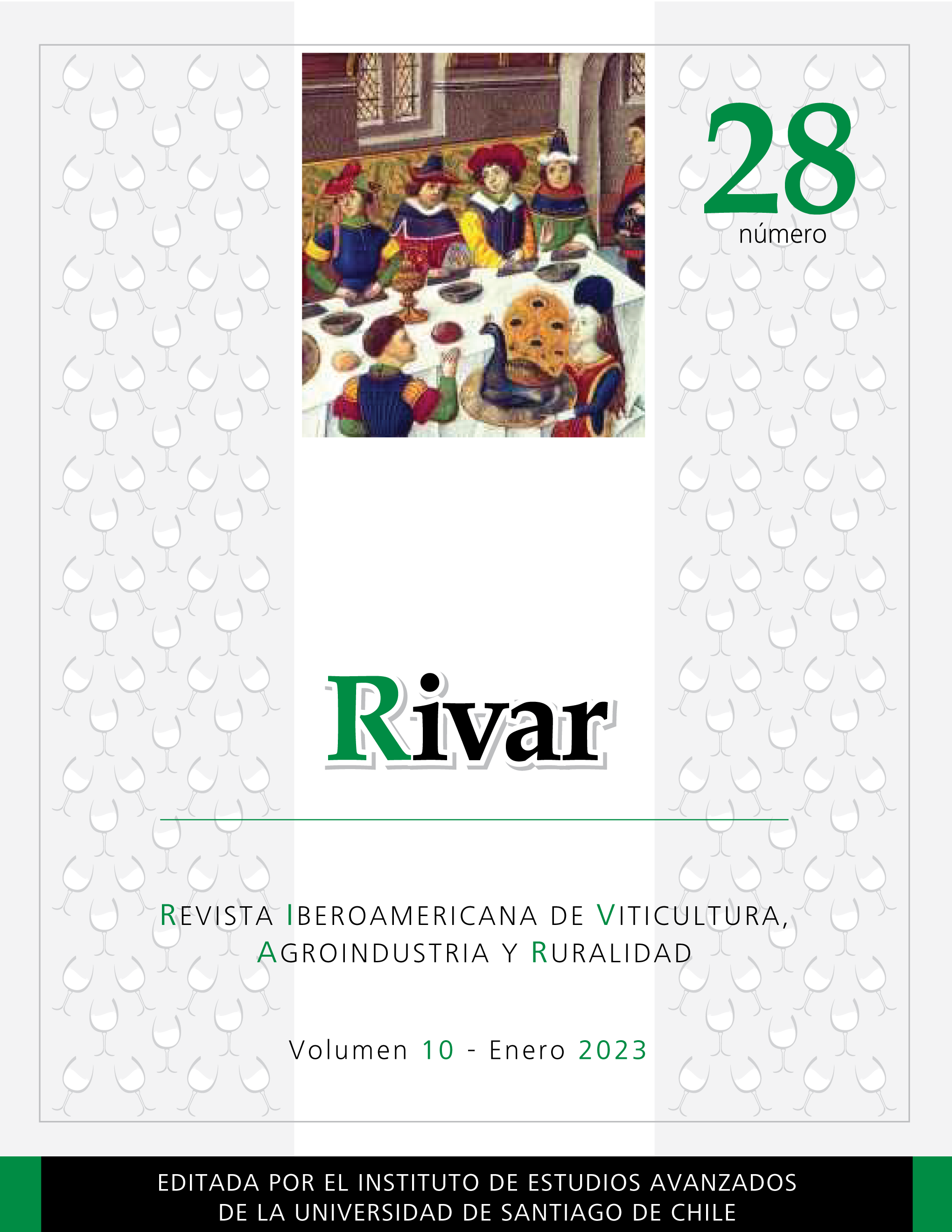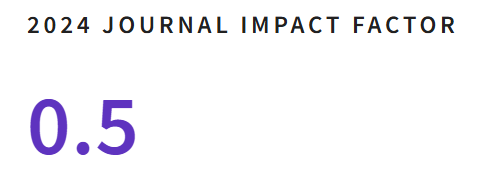Spatialized Study of Grapevine Trunk Disease in Cabernet and Chardonnay Vineyards
DOI:
https://doi.org/10.35588/rivar.v10i28.5027Keywords:
grapevine trunk diseases, radial spatial dispersion, cane pruning, spur pruning, viticultureAbstract
Grapevine trunk diseases (GTDs) are one of the most damaging phytosanitary problems in the wine industry. The main symptoms observed in the vineyard are a drastic reduction in productivity, quality, and longevity of the vines. Spatial distribution, and incidence and severity of GTDs was determined in five Cabernet Sauvignon and three Chardonnay vineyards pruned in spurs and canes, respectively. Measurements were made plant by plant and each sampling point was georeferenced using a DGPS. On the other hand, the stem water potential was determined on vines in three measurements during the season. GTDs presented an important variability at the intra-farm level mostly in Cabernet Sauvignon, and disease severity was expressed radially. The incidence of the disease in Chardonnay tended to be towards one side of the vineyards. The incidence and severity of the disease was higher in the Cabernet Sauvignon (42% of plants affected) than in Chardonnay (13% of plants affected). Cabernet Sauvignon vines were subjected to a higher level of water stress than the Chardonnay vines throughout the growing season based onto stem water potential values. Based on the results, we can suggest that there is varietal response to GTDs and pruning and water stress can increase the susceptibility of vines to GTDs.
Downloads
References
Acevedo-Opazo, C.; Valdés-Gómez, H.; Taylor, J. A., Avalo, A., Verdugo-Vásquez, N., Araya, M., Jara-Rojas, F. y Tisseyre, B. (2013). “Assessment of an Empirical Spatial Prediction Model of Vine Water Status for Irrigation Management in a Grapevine Field”. Agricultural Water Management 124: 58-68. DOI https://doi.org/10.1016/j.agwat.2013.03.018
Agustí-Brisach, C.; León, M.; García-Jiménez, J. y Armengol J. (2015). “Detection of Grapevine Fungal Trunk Pathogens on Pruning Shears and Evaluation of their Potential for Spread of Infection”. Plant Disease 99: 976-981. DOI https://doi.org/10.1094/PDIS-12-14-1283-RE
Bertsch, C.; Ramírez-Suero, M.; Magnin-Robert, M.; Larignon, P.; Chong, J.; Abou-Mansour, E.; Spagnolo, A.; Clément, C. y Fontaine, F. (2012). “Grapevine Trunk Diseases: Complex and Still Poorly Understood”. Plant Pathology 62(2): 243-265. DOI https://doi.org/10.1111/j.1365-3059.2012.02674.x
Chacón-Vozmediano, J.L.; Gramaje, D.; León, M.; Armengol, J.; Moral, J.; Izquierdo-Cañas, P.M. y Martínez-Gascueña, J. (2021). “Cultivar Susceptibility to Natural Infections Caused by Fungal Grapevine Trunk Pathogens in La Mancha Designation of Origin (Spain)”. Plants 10: 1171. DOI https://doi.org/10.3390/plants10061171
Cholet, C.; Bruez, É.; Lecomte, P.; Barsacq, A.; Martignon, T.; Giudici, M.; Simonit, M.; Rey, P.; Dubourdieu, D. y Gény, L. (2021). “Plant Resilience and Physiological Modifications Induced by Curettage of Esca-Diseased Grapevines”. OENO One 55(1): 153-169. DOI https://doi.org/10.20870/oeno-one.2021.55.1.4478
Faúndez-López, P.; Delorenzo-Arancibia, J.; Gutiérrez-Gamboa, G. y Moreno-Simunovic, Y. (2021). “Pruning Cuts Affect Wood Necrosis but not the Percentage of Budburst or Shoot Development on Spur Pruned Vines for Different Grapevine Varieties”. Vitis 60: 137-141. DOI https://doi.org/10.5073/vitis.2021.60.137-141
Fontaine, F.; Pinto, C.; Vallet, J.; Clément, C.; Gomes, A.C. y Spagnolo, A. (2015). “The Effects of Grapevine Trunk Diseases (GTDs) on Vine Physiology”. European Journal of Plant Pathology 144(4): 707-721. DOI https://doi.org/10.1007/s10658-015-0770-0
Gramaje, D.; Armengol, J.; Barajas, E.; Berbegal, M.; Chacón-Vozmediano, J.L.; Cibrian, J.; Díaz-Losada, E.; López-Manzanares, B.; Muñoz, R.; Martínez-Diz, M.P.; Rubio, J. y Següés, A. (2020). Guía de enfermedades fúngicas de la madera de la vid. Madrid, Grupo de Trabajo de Experimentación en Viticultura y Enología, Ministerio de Agricultura, Pesca y Alimentación.
Gramaje, D.; Úrbez-Torres, J.R. y Sosnowski, M.R. (2017). “Managing Grapevine Trunk Diseases with Respect to Etiology and Epidemiology: Current Strategies and Future Prospects”. Plant Disease 102(1): 12-39. DOI https://doi.org/10.1094/pdis-04-17-0512-fe
Gutiérrez-Gamboa, G., Pérez-Donoso, A. G., Pou-Mir, A., Acevedo-Opazo, C. y Valdés-Gómez, H. (2019). “Hydric Behaviour and Gas Exchange in Different Grapevine Varieties (Vitis vinifera L.) from the Maule Valley (Chile)”. South African Journal of Enology and Viticulture 40(2): 181-191. DOI https://doi.org/10.21548/40-2-3224
Henderson, B.; Sosnowski, M.R.; McCarthy, M.G. y Scott, E.S. (2021). “Incidence and Severity of Eutypa Dieback in Grapevines are Related to Total Surface Area of Pruning Wounds”. Australian Journal of Grape and Wine Research 27: 87-93. DOI https://doi.org/10.1111/ajgw.12465
Keller, M. (2020). The Science of Grapevines. Tercera edición. Ámsterdam, Elsevier.
Luque, J.; Elena, G.; Garcia-Figueres, F.; Reyes, J.; Barrios, G. y Legorburu, F.J. (2014). “Natural Infections of Pruning Wounds by Fungal Trunk Pathogens in Mature Grapevines in Catalonia (Northeast Spain)”. Australian Journal of Grape and Wine Research 20: 134-143. DOI https://doi.org/10.1111/ajgw.12046
Martínez-Diz, M. del P., Eichmeier, A., Spetik, M., Bujanda, R., Díaz-Fernández, Á., Díaz-Losada, E. y Gramaje, D. (2020). “Grapevine Pruning Time Affects Natural Wound Colonization by Wood-Invading Fungi”. Fungal Ecology 48: 100994. DOI https://doi.org/10.1016/j.funeco.2020.100994
Mondello, V.; Songy, A.; Battiston, E.; Pinto, C.; Coppin, C.; Trotel-Aziz, P.; Clément, C.; Mugnai, L. y Fontaine, F. (2018). “Grapevine Trunk Diseases: A Review of Fifteen Years of Trials for their Control with Chemicals and Biocontrol Agents”. Plant Disease 102(7): 1189-1217. DOI https://doi.org/10.1094/pdis-08-17-1181-fe
Mostert, L.; Groenewald, J.Z.; Summerbell, R.C.; Gams, W. y Crous, P.W. (2006). “Taxonomy and Pathology of Togninia (Diaporthales) and its Phaeoacremonium Anamorphs”. Studies in Mycology 54: 1-113. DOI https://doi.org/10.3114/sim.54.1.1
Moyo, P.; Allsopp, E.; Roets, F.; Mostert, L. y Halleen, F. (2014). “Arthropods Vector Grapevine Trunk Disease Pathogens”. Phytopathology 104: 1063-1069. DOI https://doi.org/10.1094/PHYTO-11-13-0303-R
Ortega-Farias, S.; Lozano, P.; Moreno, Y. y Leon, L. (2002). “Desarrollo de modelos predictivos de fenología y evolución de madurez en vid para vino cv. Cabernet Sauvignon y Chardonnay”. Agricultura Técnica 62: 27-37. DOI https://doi.org/10.4067/s0365-28072002000100003
Ouadi, L.; Bruez, E.; Bastien, S.; Vallance, J.; Lecomte, P.; Domec, J.C. y Rey, P. (2019). “Ecophysiological Impacts of Esca, a Devastating Grapevine Trunk Disease on Vitis vinifera L.”. PLOS ONE 14(9): e0222586. DOI https://doi.org/10.1371/journal.pone.0222586
Sosnowski, M.; Luque, J.; Loschiavo, A.; Martos, S.; García-Figueres, F.; Wicks, T.J. y Scott, E.S. (2011). “Studies on the Effect of Water and Temperature Stress on Grapevines Inoculated with Eutypa lata”. Phytopathologia Mediterranea 50: 127-138.
Sosnowski, M.; Ayres, M. y Scott, E. (2020). “The Influence of Water Deficit Stress on the Grapevine Trunk Disease Pathogens”. Eutypa lata and Diplodia seriata. Plant Disease 105: 2217-2221. DOI https://doi.org/10.1094/PDIS-07-20-1538-RE
Verdugo-Vásquez, N.; Acevedo-Opazo, C.; Valdés-Gómez, H.; Araya-Alman, M.; Ingram, B.; García de Cortázar-Atauri, I. y Tisseyre, B. (2016). “Spatial Variability of Phenology in Two Irrigated Grapevine Cultivar Growing under Semi-Arid Conditions”. Precision Agriculture 17(2): 218-245. DOI https://doi.org/10.1007/s11119-015-9418-5
Verdugo-Vásquez, N.; Acevedo-Opazo, C.; Valdés-Gómez, H.; Ingram, B.; García de Cortázar-Atauri, I. y Tisseyre, B. (2018). “Temporal Stability of Within-Field Variability of Total Soluble Solids of Grapevine under Semi-Arid Conditions: A First Step Towards a Spatial Model”. OENO One 52(1): 15-30. DOI https://doi.org/10.20870/oeno-one.2018.52.1.1782









